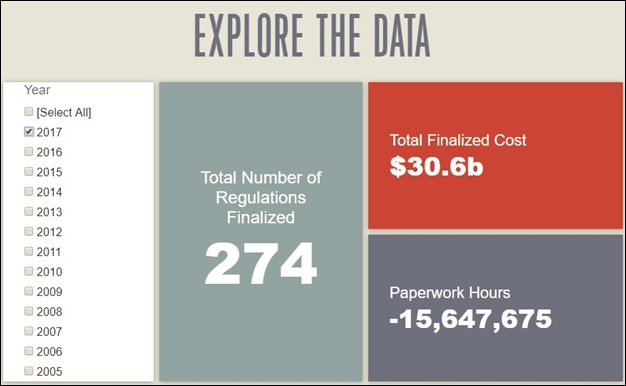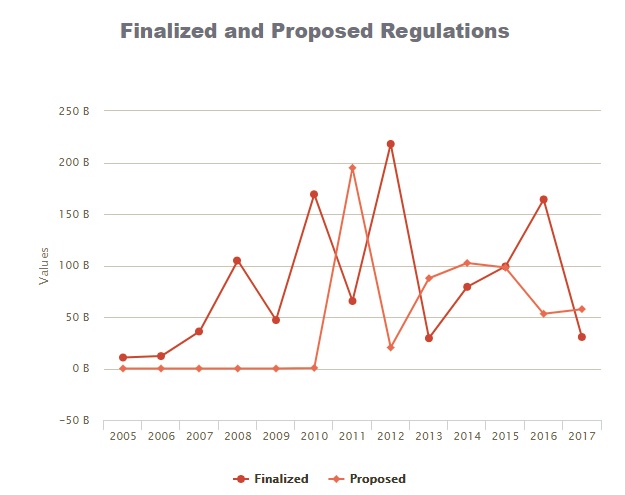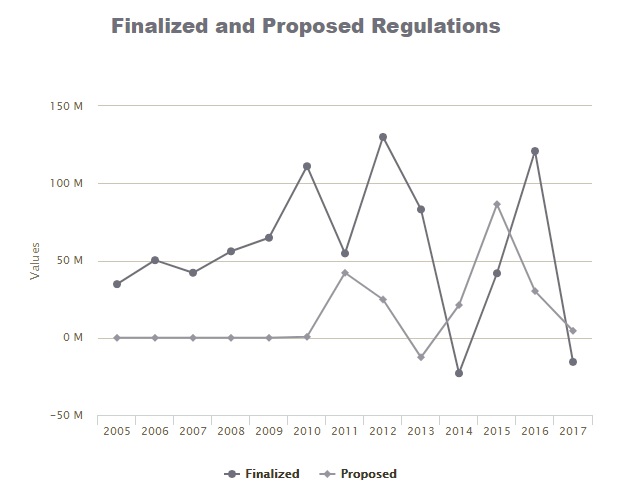Research
January 5, 2018
2017: The Year in Regulation
The trend of regulatory activity shifted dramatically in 2017 once President Trump assumed the presidency. American Action Forum (AAF) research found that in 2017 federal agencies finalized 274 regulations that imposed $30.6 billion in total costs, relative to the regulatory burden at the end of 2016. These agencies simultaneously trimmed 15.6 million paperwork burden hours. What is most noteworthy is the disparity in the regulatory activity of the last three weeks of the Obama Administration versus the more than 11 months of the Trump Administration. Despite substantial new regulatory costs finalized in the last weeks of the Obama Administration, the Trump Administration made significant progress in slowing this growth the remainder of the year. In fact, 81 percent of all regulatory costs finalized in 2017 came during President Obama’s final weeks in office.
SNAPSHOT
Other Notable Points:
- Final Annual Costs: $10.3 billion
- Total Final Costs Per Person: $94.74
- Total Proposed Costs: $57.6 billion
- Proposed Paperwork Hours: 4.5 million
The 274 finalized rules are the fewest since 2005, the first year for which AAF has data. The $30.6 billion in finalized costs is the lowest since 2013, when agencies imposed $29.5 billion. However, that same year agencies increased paperwork burden hours by 83 million. The 2017 paperwork reductions are the second-fewest since 2005, eclipsed only by the 23 million hours reduced in 2014.
Of the $30.6 billion in finalized costs last year, $24.8 billion came from 38 rules published from January 3-19, 2017, in the waning days of the Obama Administration. On January 30, 2017, President Trump formalized his regulatory vision by signing Executive Order 13,771, which set a goal of no new additional costs from significant regulation through the end of the fiscal year.
President Trump achieved his goal based on how the executive order narrowly defined covered rules from executive agencies. However, AAF tracks regulatory activity from all federal agencies, including independent agencies, and counts all actions with notable estimated costs or paperwork changes. Still, the imposition of just $5.8 billion in new regulatory costs in nearly a year is a considerable feat for the Trump Administration. It is even more notable because it includes $6.7 billion from independent agencies; if one merely looks at executive agencies (those under the direct control of the administration), that yields a total of more than $900 million in total costs savings.
While these figures only take administrative actions into consideration, one of the most notable regulatory policy stories of 2017 came from the legislative side in the form of a historic set of resolutions of disapproval under the Congressional Review Act (CRA). Before 2017, the only successful CRA resolution came on a 2001 Department of Labor ergonomics rule. In 2017, between 14 such resolutions in the spring concerning Obama-era regulations and one more in the fall concerning a Consumer Financial Protection Bureau (CFPB) rule, Congress and President Trump utilized the CRA to overturn 15 rules accounting for roughly $4 billion in total cost savings. The graph below illustrates the drastic shift in regulatory approaches over the past year.
COSTLIEST RULES
The disparity in the Obama and Trump Administrations is illustrated by looking at the 10 costliest rules finalized in 2017. Of the 10 listed in the table below, we assigned seven to the Obama Administration, based on the date of publication in the Federal Register. Of the three we assigned to the Trump Administration (marked by an asterisk) two were finalized by independent agencies that are not reviewed by the White House.
- Energy Conservation Standards for Residential Central Air Conditioners: $12.3 billion
- Energy Conservation Standards for Ceiling Fans: $4.4 billion
- Securities Transaction Settlement Cycle: $4.2 billion*
- Energy Conservation Standards for Dedicated-Purpose Pool Pumps: $2.6 billion
- Requirements for Systemically Important U.S. Bank Holding Companies: $2 billion*
- Strengthening the Home Equity Conversion Mortgage Program: $1.9 billion
- Medicare and Medicaid: Conditions of Participation for Home Health Agencies: $1.3 billion
- Occupational Exposure to Beryllium: $630 million
- Energy Conservation Standards for Walk-In Cooler and Freezer: $600 million*
- Federal Policy for the Protection of Human Subjects: $528 million
These 10 rules have a combined estimated cost of $30.5 billion of the $30.6 billion total for 2017 (or roughly 99.7 percent).
BIGGEST SAVINGS
Similarly, the 10 rules that yielded the most savings in terms of estimated regulatory costs come mostly from the Trump Administration. Eight of the 10 rules listed below were published in the Federal Register after January 19, 2017, with one of those coming from an independent agency. The rules finalized by the Obama Administration are marked with an asterisk.
- 18-Month Extension of Transition Period and Delay of Applicability Dates; Fiduciary Rule: -$2.2 billion
- Metropolitan Planning Organization Coordination and Planning Area Reform: -$330 million
- SNAP: Eligibility, Certification, and Employment and Training: -$286 million*
- Medicare and Medicaid Programs; CY 2018 Home Health Prospective Payment System Rate Update: -$146 million
- Fiduciary Delay to Allow Review of Rule: -$123 million
- Home Mortgage Disclosure (Regulation C): -$60 million
- Scope of Sections 202(a) and (b) of the Packers and Stockyards Act: -$53 million
- Waste Prevention, Production Subject to Royalties, and Resource Conservation; Delay and Suspension: -$46 million
- Alternative Pilot Physical Examination and Education: -$42 million*
- Postponement of Certain Compliance Dates for the Effluent Limitations Guidelines: -$37 million
These 10 rules accounted for $3.3 billion of the $3.5 billion worth of estimated cost savings from 29 rules finalized in 2017 (approximately 94.2 percent).
TOP AGENCIES BY REGULATORY AND DEREGULATORY COSTS
As suggested by the list of costliest rules for 2017, the Department of Energy imposed the most costs of any agency last year with $20 billion worth of total costs. The Securities and Exchange Commission imposed the second-most with $4.2 billion worth of mandates. The Department of Health and Human Services ranked third with $2.3 billion.
On the deregulatory side of the ledger, the Department of Labor – which led all agencies in regulatory costs in 2016 primarily because of its Fiduciary Rule – led the way because of actions taken to delay the same rule. The sum of its 2017 rules equaled $1.3 billion in estimated savings. The Department of the Interior ranked second with $83 million saved. Only one other agency had net savings produced in 2017 – the Pension Benefits Guaranty Corporation with $26,000 saved.
PAPERWORK
Interestingly, in a year noteworthy for the Trump Administration’s deregulatory efforts, the biggest reduction in paperwork burdens came from the Obama Administration. Its rule implementing changes in the Supplemental Nutrition Assistance Program, passed by Congress in 2008, reduced paperwork by 40.5 million hours, far and away the most of any rule last year. Aside from that effort, 14 other rules reduced paperwork burden by a combined total of 4.7 million hours. Without the SNAP rule, paperwork burdens would have increased by 24.8 million hours.
Five of the six rules imposing the most paperwork from 2017 came while President Obama was still in office. Those five rules added 13.5 million hours of paperwork.
The rule with the most paperwork added was finalized by the CFPB in November 2017. The Bureau’s Payday, Vehicle Title, and Certain High-Cost Installment Loans rule added some 8.2 million in new paperwork burden hours.
PROPOSED RULES
The rules proposed by agencies in 2017 more clearly demonstrate the difference in the regulatory agendas of the Obama and Trump Administrations. Prior to leaving office, the Obama Administration proposed more than $111 billion in new regulatory costs. Nearly all of these regulatory costs were proposed in the Department of Transportation’s Vehicle-to-Vehicle Communications rule ($108.9 billion). That rule has been reclassified as a long-term action by the Trump Administration in its latest Unified Agenda of Regulatory and Deregulatory Actions, meaning no action is expected in the coming year. A similar fate has met many pending actions proposed by the Obama Administration – many have been punted to long-term status, or withdrawn outright.
In contrast, actions proposed by the Trump Administration would reduce total estimated regulatory costs by $53.5 billion, if each is finalized as proposed. While this is unlikely, the message is clear: agencies are actively looking to cut regulatory costs.
The agenda is similar for proposed paperwork burdens, although both administrations proposed net paperwork increases in 2017. For the year, agencies proposed 4.5 million new paperwork burden hours. Of that total, the Obama Administration proposed 2.9 million hours while the Trump Administration proposed 1.6 million additional hours. It will be worth watching how the Trump Administration adheres to those proposed estimates as those rules become finalized in the coming years.
2017 COMPARED TO PREVIOUS YEARS
Had the Trump Administration been in office since January 1, 2017, the contrasts between this year and previous years for which AAF has data would be unmistakably striking. However, the flurry of regulatory activity in the waning days of the Obama Administration makes 2017 noteworthy but not extraordinary in terms of regulatory activity.
What is encouraging is that when taken together, the number of finalized and proposed costs and paperwork burdens clearly declined in 2017. In 2013, when finalized regulatory costs were similar to this year’s, proposed regulatory costs and finalized paperwork burdens were significantly higher than 2017. In 2014 when finalized paperwork reductions were greater than those finalized this year, new paperwork burdens were higher than 2017.
The graphs below illustrate this point. It is important to note that, for years prior to 2011, AAF has incomplete data on the estimated costs of proposed regulations and paperwork burdens. The first graph shows total costs.
The second graph shows finalized and proposed paperwork burdens.
2017 marked a sea change in the regulatory paradigm. Will it turn out to be an aberration of deregulatory activity? Time will tell. But the Trump Administration’s latest regulatory agenda and proposed deregulatory measures heading into 2018 point to a continued shift towards reducing regulatory costs and new paperwork mandates.















